Fly Fishing Basics: Pretest
Mastering the Basics of Fly Fishing
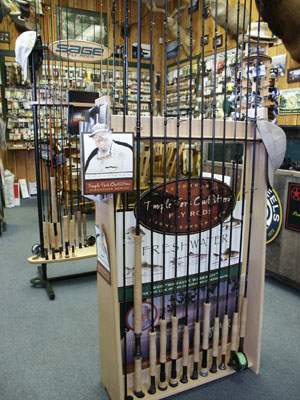
Mastering the Basics of Fly Fishing was originally an outline that I followed when I taught classes on fly fishing. Working for an outfitter and fly shop owner in Hamilton, Montana, I taught a number of parent/child introductory classes. Later when I set up my Montana Fly Fishing site in the early 90's, I expanded this article for adults who wanted to learn on their own, as well as parents wanting to teach their children the skills of fly fishing. It continues to be one of the most visited sections on my Montana site. The instructional program is broken down into the following steps:
Introduction
Step 1: Pre and Post Test
Step 2: Terminal equipment and Paraphernalia
Step 3: Necessary Knots and Leaders
Step 4: Casting
Step 5: Basic Fly Patterns and Presentation
Step 6: Mastering the Basics of Creek Fishing
Step 7: Mastering the Basics of Stillwater Fly Fishing
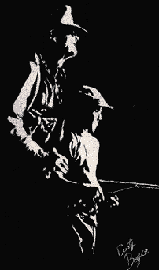
Introduction and Pre / Post Test for Mastering the Basics of Fly Fishing
In thirty-two years of being a high school English teacher and fifteen years of being a fly fishing instructor and guide, I have learned a great deal about teaching and learning. Too often, I must confess, I departed from good instructional techniques with predictable results-- a loss of interest or frustration on the part of the learner. Through the years I have watched ardent fly fishermen attempt fly fishing "conversions" with family members and friends --often with the same predictable results.
Attempting to share one's boundless enthusiasm with a spouse or child evokes a host of clichés. Suffice to say there are minefields in all of our backyards that the skilled instructor must carefully clear away. Many families have stories about spouses stepping into the instructor or learner role with disastrous results. Sadly, the same may be said of parents attempting to teach fly fishing to their children.
Too often we expect our enthusiasm as instructor to motivate the learner or novice, and the ensuing frustration on the learner's part or the instructor's part creates tension, which sometimes leads to conflict or withdrawal. To avoid this quagmire, don't loose sight of the most important ingredients for success: fun and rewards.
Ideally, an instructor should be a skilled communicator, knowledgeable, enthusiastic, patient, constantly supportive and realistic in his or her expectations for the learner. Hopefully, the learner has not been "overly coerced", is genuinely eager, has good listening skills and is blessed with superior fine motor skills. If you or your learner lacks any of the above attributes, as most of us surly do, then I hope this manual will help both of you through a sequential skills program. The guiding principle for this manual is the basic philosophy that success needs to be recognized and rewarded, realistic goals need to be established, and instruction should be given in small increments. At all times the instructor and learner need to concentrate on having fun! With each skill lesson, determine how you can make the lesson fun. If you are working with a youngster, how will you reward him or her for mastering a particular level? I started out with flies and gadgets.
Each section provides basic information which should be learned before moving on to the next level of instruction. At the beginning of each skill lesson, a survey will test existing knowledge or skill acquisition. Additionally, practical advice may be offered to the instructor if the learner is a child. Tests are essentially used to review. Avoid using the tests to rate success. Use the test to reinforce and review. Success should be measured on the basis of whether or not you are having fun and enjoying each other's company.
Regarding the age to start children fly fishing, I would offer this advice. First teach them the joy of outdoor recreation. Introduce them to pond fishing for sun fish where they are sure to have success with a nymph and strike indicator. At about fourth grade, when their fine motor skills are sufficiently developed, begin instruction with the clear understanding that the goal is self-sufficiency. Start the program during the winter so that when the first family trout trek arrives, the instructor isn't impatiently giving the learner a crash course. Take them to a small creek. And speaking of small creeks, I would recommend buying the primer, The Curtis Creek Manifesto written and illustrated by Sheridan Anderson. This wonderful angling comic book is published by Frank Amato Publications in Portland, Oregon.
Having got "skunked" his first time out, my ten year old son turned to me and said, "Dad, I like casting to the hula hoops better, especially with all the prizes." It was a chilly May opener and a bungled first experience with a fly rod for a youngster. Later that summer Darin and my seven year old son, Brandon, caught a number of five inch Brook trout on a tiny creek high above Montana's famous Big Hole. Through the years I have seen many fathers completely turn off their children to fly fishing. My two boys were delighted with their catch, but they really didn't want to catch any more than a couple of fish. We had only been gone from camp twenty minutes. Fortunately, I was smart enough to reel in their lines and join them in their search for water snakes. We now share a common bond, a fellowship as fly fishers.
Pre and Post Test
If you are a novice, use these questions to determine areas that you will need to spend the most time. If you are teaching a child, be somewhat selective based on their age and how much they have been exposed to fly fishing.
Step 1: Identification of Equipment
1. If someone gave you just a rod, how would you determine what weight fly line to use with it?
2. What is the most versatile weight fly line for trout fishing?
3. True / False: Rod bend or flex is subjective and based on how slow or fast one's preference is in casting.
4. Although seldom used on small streams, the drag adjustment on a single action reel is valuable under what conditions?
5. Briefly discuss the advantage of a double tapered fly line and a weight forward line.
6. What is a leader butt used for? On a piece of paper, draw a leader butt and identify each of the knots used.
7. What is a tippet?
8. What is fly dressing?
9. What use does a fly fisher have of hemostats?
10. Which is the most common leader length?
3-5 ft
4-6 ft
7-9 ft
12-14 ft
11. What is the advantage of using Polaroid sun glasses?
12. If you are fishing with a floating fly line, and then you decide to tie on a nymph and fish the sub-surface or the bottom of the stream, what techniques can you employ without changing your fly line?
13. What two knots do you have to choose from to tie at the end of a leader butt?
14. Why would your dentist highly recommend that you carry fingernail clippers with you when you go fishing?
15. Look over the following knots to determine which of the six you will need to learn.

Step 2: Basic Set Up
1. Name the four critical specifications found on all AFTMA fly lines.
2. Rods are designed to cast a particular weighted fly line. The lines are numbered 1 - 12. Which line(s) would be most practical for the majority of your fishing waters? Briefly explain your reasons.
3. Why is it both practical and potentially useful to first add braided backing to your reel?
Step 3: Necessary Knots (Name each of the knots pictured.)
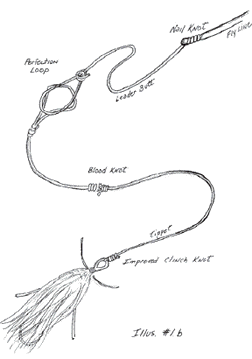
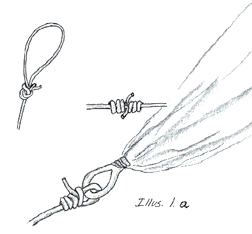
Step 4: Casting
Place a large plate, a hoola-hoop or a pizza box out on the lawn at a distance of 20 feet. Cast your fly so it lands within a foot with three attempts. (Be sure to remove the hook portion of the fly. You may also just tie on a little piece of yarn.) Cast your fly at a plate at thirty feet so that it lands within two feet of the plate with three attempts. Now you have a baseline to measure how much you will have improved after you start the casting program.
Multiple Choice and True/False Questions:
1. A fly fishing rod, reel and line is said to be balanced when:
A. The line weight matches the recommended rod weight
B. The outfit is color coordinated
C. You can balance or hold the rod level on an extended finger with the
balance point usually close to where the grip stops and the rod begins.
2. T/F The forward cast is more important than the back cast for distance and presentation.
3. Generally, when casting, the caster wants:
A. An open loop
B. A swing loop
C. A tight loop
D. No loop
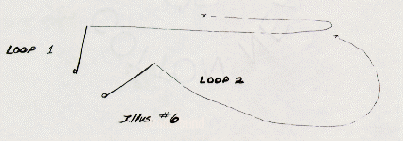
4. When a caster does not let the line land on the water and
continues casting overhead, forward and backward, he or she is said to
be:
A. Shadow darting
B. False casting
C. Air line
D. Wasting time
5. What are three useful reasons for the answer to question 4?
6. Viewing the caster from behind, which is the better cast and why?
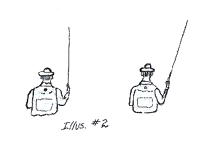
7. Line drag spooks the fish and frustrates the caster when the faster current pushes the belly or mid-section of the line downstream. This causes an unnatural drag or acceleration of the fly. This constant factor is the fly fisher's greatest challenge to over come. Trout are creatures of habit, and they are conditioned by their environment. Viewing an artificial fly pattern zoom by their lie will not trigger a strike, as it is an unnatural phenomenon; therefore, the fly fisher has to cast in such a manner so as to drift the fly in a natural float. Describe two types of casts or casting technique that may be used to counter this problem of line drag?
8. Which is more important in casting, distance or presentation?
9. A steeple cast or a roll cast is most useful under what conditions?
10. The basic power stroke or casting arc can be illustrated on the following clock. Draw two lines connecting the large dot with the smaller dot or number which will demonstrate where the rod stops on the back cast and forward cast.
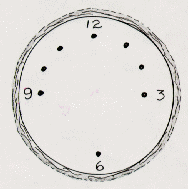
11. Which lettered illustration depicts the proper pick up of line off the water prior to starting into your back cast? A, B or C?
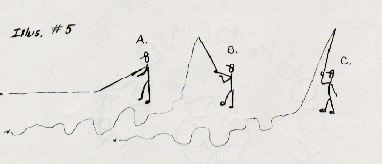
12. Which is the best loop for casting?
13. What is a "wind knot" and how is it caused?
14. You find your fly splashing on the water behind you or catching on the grass. What two corrections should you make?
15. What forward casting adjustment could you make if you see your fly smashing onto the water with a splat?
16. If on your forward cast, your fly line and leader drift back towards you dropping into an unsightly pile, what forward cast adjustment do you need to make?
17. If you snap your fly off in mid air on a "crack-the-whip" cast, what forward cast adjustment do you need to make?
18. If on your forward cast, your line hits another part of the line or the rod during the cast, you will want to make an adjustment by _____________ your rod.
19. Most fish are caught on casts of __________
A. 5-10 feet
B. 20-40 feet
C. 40-50 feet
D. 50-70 feet
20. How would you compensate for the wind while casting?
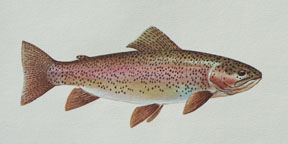
21. Identify the fish in the picture above.

22. Identify the fish in the picture above.
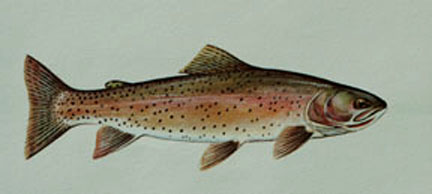
23. Identify the fish in the picture above.

24. Identify the fish in the picture above.
Step 5: Basic Fly Patterns: Identify the following popular fly patterns. See Step 5 for 20 Recommended Fly Patterns.
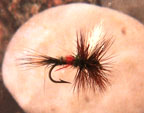

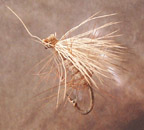
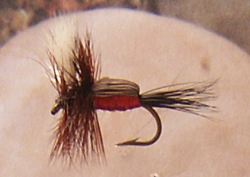
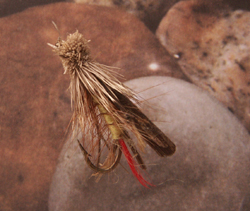
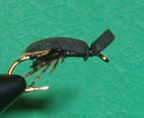
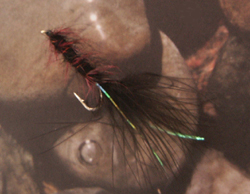
The L.L. Bean Ultimate Book of Fly Fishing by Macauley Lord, Dick Talleur and Dave Whitlock
If I had a nickel for every how-to-fly fishing book that has been published during the last 20 years, I'd be fishing around the world in some pretty exotic places. My article "Mastering the Basics of Fly Fishing" was begun hastily years ago when I was preparing an outline for an introductory course for fathers and sons. Recently I was perusing the shelves for a primer to double check that I hadn't left anything out of my article. The Ultimate Book of Fly Fishing may be an overstatement; nonetheless it is a wonderful primer for the novice or beginner. The book is divided into three sections: Fly Fishing, Fly Casting, and Fly Tying. The photographs and diagrams are exceptional, and I couldn't resist adding another fly fishing book to my collection.
Go to Step 1: Identification and Function of Equipment
For additional freshwater fishing tips, visit Dave's companion site, Fishing Tips 101.

Leave a comment